An Inventory of the Historical Monuments in Dorset, Volume 2, South east. Originally published by Her Majesty's Stationery Office, London, 1970.
This free content was digitised by double rekeying. All rights reserved.
'Steeple', in An Inventory of the Historical Monuments in Dorset, Volume 2, South east, (London, 1970) pp. 268-273. British History Online https://www.british-history.ac.uk/rchme/dorset/vol2/pp268-273 [accessed 25 April 2024]
In this section
31 STEEPLE (9180)
(O.S. 6 ins. aSY 88 SB, bSY 97 NW, cSY 98 SW)
The parish, covering nearly 3,000 acres, lies 4 m. S.S.W. of Wareham. It stretches some 3½ m. from N. to S. and has a small projection reaching to the low Kimmeridge Clay cliffs of Kimmeridge Bay. From the sea the ground rises steeply to an E.–W. ridge of Portland and Purbeck Stone and then falls again to the deep valley of the West Corfe River cut in the soft Wealden Beds. On the N. side of this valley the steep hog'sback ridge of the Chalk Purbeck Hills rises to a height of more than 600 ft. Under the N. slope of the ridge is a band of Reading Beds and London Clay, partly occupied by the park and woods of Creech Grange, beyond which a large tract of undulating heathland stretches N. on Bagshot Beds, all under 200 ft. above O.D.
As in other Purbeck parishes, many of the scattered farms are recorded in Domesday Book as tiny settlements. Each is associated with a near-by rectangular block of land, the shape of which is still preserved in continuous lines of field boundaries (see Pt. 1, Fig. p. xxxviii); some have earthwork remains of the early settlements. In the valley of the W. Corfe River, S. of the Purbeck Hills, are Lutton, Steeple itself, Blackmanston and Hurpston. Hyde, though not recorded until 1244, may also be an early settlement. N. of the Purbeck Hills settlements at West Creech and Creech Grange are probably two of the four Creeches listed in Domesday Book.
Local stone has been used for the walls of the older buildings and stone slates for most of the roofs. Among the later farms scattered over the N. part of the parish, all but two are of a date later than 1850 and in these two some use is made of cob. Together with Lutton they lie in the Army range area and are derelict.
The Church, Creech Grange and its Chapel and Steeple Manor House are the principal monuments.
Ecclesiastical
c(1) The Parish Church of St. Michael stands in the S. part of the parish and has walls of rubble and ashlar and roofs covered with stone slates. The Nave was built early in the 12th century and retains the original S. doorway. The West Tower was added early in the 16th century, the South Chapel (now the Vestry) later in the same century, and the North Pew early in the 17th century. The chancel arch is probably of the 16th century although the Chancel was mostly rebuilt between 1852 and 1861, when also the South Porch was rebuilt.
Architectural Description—The Chancel (16¾ ft. by 13¼ ft.) has in the S. wall a 16th-century two-centred archway to the S. chapel. The chancel arch is two-centred, of one chamfered order with continuous stop-chamfered responds above a chamfered plinth. This last, which is continued to return along the N. and S. walls of the nave, is of 12th-century origin. The South Chapel (9 ft. by 12½ ft.) has walls of squared rubble with a chamfered plinth; to the E. is a window of three cinque-foiled lights in square head; a similar window to the S. has a moulded label with returned stops; the W. doorway has moulded jambs and continuous segmental head. High in the N.W. corner a corbel carries the upper part of the original S.E. corner of the nave.
The Nave (39½ ft. by 16½ ft.) has walls of random rubble; they were heightened in the 15th century; the N. wall has, at the W. end, the chamfered plinth of a clasping buttress; the opening to the N. pew has a two-centred arched head of two orders, the inner chamfered and carried on shaped corbels with moulded imposts; the N. door, now blocked, has moulded jambs and lintel and deformed semicircular rear arch, partly rebuilt; the window is a single lancet light of the 13th century. The S. wall has a restored S. doorway with stop-chamfered jambs, moulded imposts and a semicircular-arched head of two chamfered orders with a chamfered label, and three 15th-century windows each of two cinque-foiled lights in a square head with a label, the W. one only having casementmoulded reveals; the upper part of the eastern window has been restored. High in the W. part of the wall is a 17th century window of two square-headed lights with ovolo-moulded reveals and modern mullion. The North Pew (12¾ ft. by 16 ft.) is of coursed rubble with a plinth to the N. wall only; in the E. wall is a doorway with chamfered jambs and continuous four-centred head within a square outer head, chamfered with sunk spandrels. Over the door is a sunk panel carved with a shield-of-arms of Lawrence quartering Washington with crest above, also in a shield, and with initials and date E L 1616, for Edward Lawrence. The E. window has three four-centred lights in a square head; the N. window has three square-headed lights with a restored label.
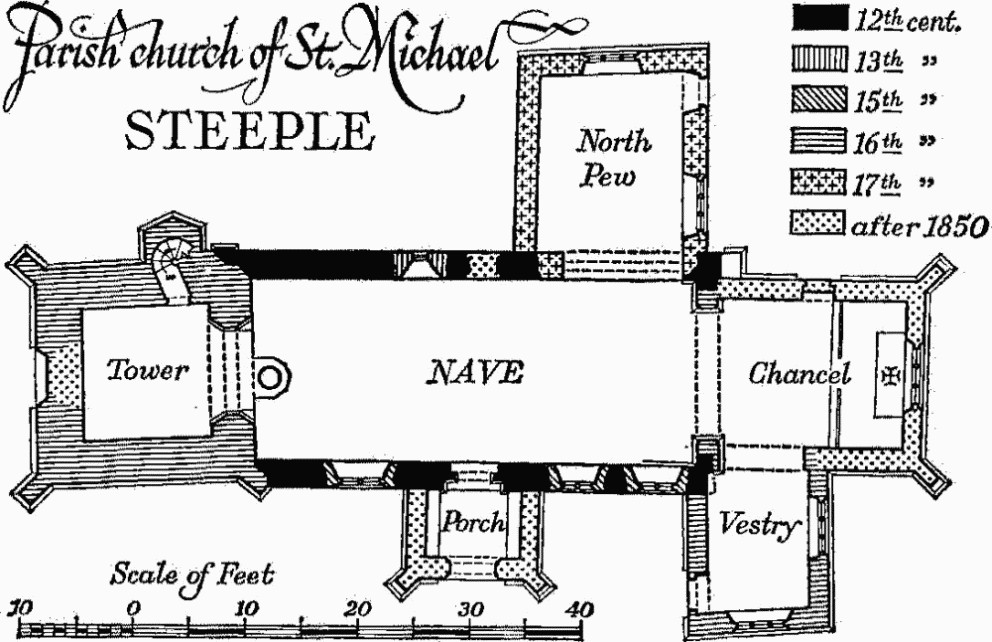
Parish Church of St. Michael, Steeple
The West Tower (11¾ ft. by 11¼ ft.) is of ashlar and of three storeys divided externally into two stages by a moulded string-course, and has a moulded plinth, plain parapet, diagonal two-stage buttresses and a projecting stair turret at the N.E. corner. The tower arch is two-centred with continuous jambs splayed to E. and W. above a plain plinth; above the tower arch and below the nave ceiling is the weathering for a former low-pitched roof to the nave; the doorway to the stair turret has a chamfered two-centred head and continuous jambs; the W. window has been entirely renewed and the head probably lowered and below it is a blocked doorway with two-centred head and continuous splayed jambs. At the top of the lower stage and lighting the second internal storey is a rectangular opening in the N. wall. The upper stage has a window of two square-headed lights in each face. The South Porch (8¼ ft. by 6 ft.) is modern; reset in the E. wall is a carved shield-of-arms of Lawrence quartering Washington, with initials DLE and crest.
The Roof of the nave is ceiled with a 17th-century plaster barrel vault, renewed in 1954, divided into five bays each of four panels with shields-of-arms at the intersections, of Lawrence quartering Washington. The N. pew has an open timber roof of the late 19th century. The S. chapel has a plain ceiling.
Fittings—Bells: three; 1st inscribed 'Sancta Anna Ora Pro Nobis' with a maker's mark in the form of a rebus of William Calverden (Plate 5), early 16th-century, rehung 1961; 2nd and 3rd loose in tower, by Anthony Bond, 1634. Also, loose in nave, two bells from Tyneham church: 1st inscribed 'in nomine domini', c. 1500; 2nd by R. Wells, Aldborne, 1784. Bell-frame: 17th-century, now dismantled. Brackets: in nave, on S. wall flanking E. window, two shaped stone corbels. Brass Indent: in chancel, for small rectangular plate. Coffin-lids: In chancel, reset in N. wall, (1) of Purbeck marble, 1¾ ft. long, with raised trefoiled cross on stepped Calvary; in churchyard, S. of porch, (2) with raised foliated cross on stepped Calvary; c. 1300. Coffin Stools: pair, with turned legs, late 17th-century. Communion Rails: of pine with turned balusters between plain square standards, early 19th-century. Font: Tapered circular bowl on plain circular stem and base, 13th-century, on modern octagonal plinth. Monuments and Floor-slabs. Monuments: in chancel, on S. wall, (1) to Francis Chaldecot, 1636, and Edith (Chaldecot) his wife, 1638, erected by William Chaldecot, their son, 1641, inscribed slate tablet within an arched alabaster surround carved with lions' masks and cherub's head between two doves and side scrolls and surmounted by cornice supporting shield-of-arms of Chaldecot impaling Chaldecot. Floor-slabs: in chancel, (1) to Mary, second wife of Nathaniel Bond, 1798; (2) to Elizabeth, wife of Nathaniel Bond, 1674; (3) to Sarah, wife of William Collens, 1675; (4) to Denis Bond of Grange, 1746. Painting: in nave on N. wall, stencilled flower sprays, perhaps early 17th-century. Plate: includes cup and cover-paten by Lawrence Stratford of Dorchester, 1574; stand paten with arms of Bond impaling Williams, 1716. Table: in nave, of oak with moulded square legs and moulded central stretcher, late 18th-century.
c(2) Chapel of St. John the Evangelist, at Creech Grange, has walls faced with local ashlar and roofs covered with stone slates and modern asbestos. It was built in 1746 by Denis Bond of Creech Grange and originally consisted of a nave with a small sanctuary entered through a mid 12th-century archway (Plate 161), brought from the priory church at East Holme, and a W. tower. In 1849 the Rev. Nathaniel Bond rebuilt the Nave and Tower and added the North Transept; the tower bell-turret was added later. In 1868 the Chancel and the Vestry and Organ Chamber were built, the former S. doorway was moved to the W. wall of the tower and the S. wall of the nave refenestrated. Nothing remains of the 1840 refitting (see Fittings, Glass, below).
The reused 12th-century archway from East Holme is a notable Romanesque feature.
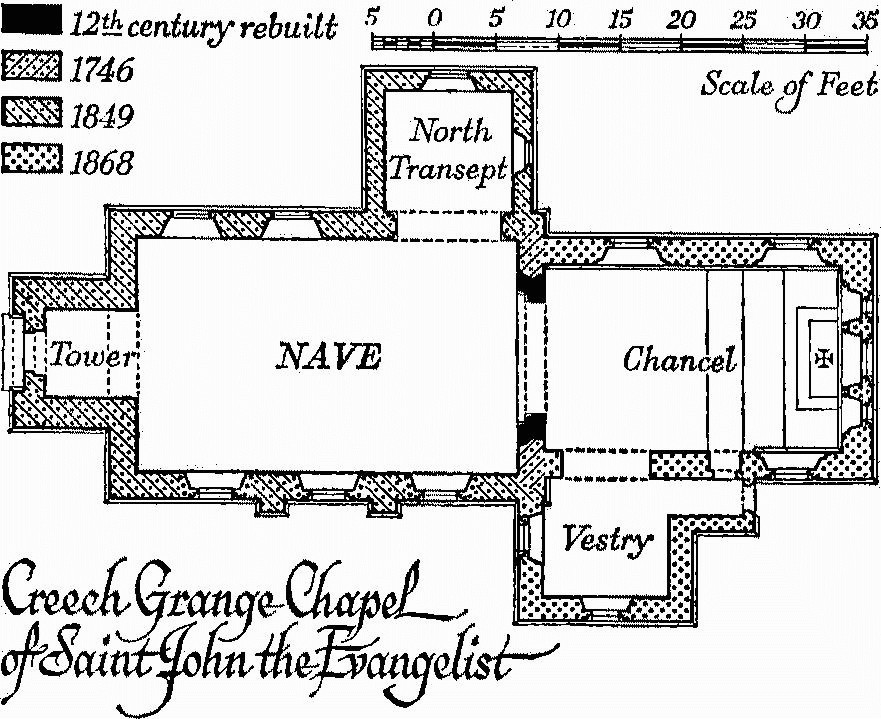
Creech Grange, Chapel of Saint John the Evangelist
Architectural Description—The Chancel Arch is semicircular and of one plain order on the E. and of two orders on the W., the inner order enriched with chevron ornament and the outer with chevrons enclosing paterae and with bead and nailhead ornament; the responds have engaged shafts with carved capitals and moulded abaci which are continued to meet the N. and S. walls. The shafts stand on 12th-century capitals reused as bases. The Nave (31 ft. by 18½ ft.) has in the N. wall an archway to the N. transept of 1849 in 12th-century style and two windows of single round-headed lights with labels also of 1849; in the S. wall are three windows of 1868 with earlier buttresses between them. The North Transept (10 ft. by 9½ ft.) has windows in the E. and N. walls of single round-headed lights with labels uniform with those in the N. wall of the nave. The West Tower (5 ft. by 7 ft.) is of two stages surmounted by a bell-turret; the tower arch is round-headed and springs from reused moulded imposts of the 12th century. The W. doorway has a segmental head under an archway enriched with chevron ornament of 1849 in 12th-century style.
Fittings—Bell: one, inaccessible, probably 19th-century. Font: octagonal stone bowl moulded on the under side on octagonal black marble shaft, 1849. Glass: in E. window, with roundels of the Adoration of the Shepherds, the Crucifixion and the Ascension, and inscription: 'This Chapel was fitted up at the expense of John Bond of Grange Esq. as a Chapel of Ease to the Parish of Steeple A.D. 1840. He survived this good work only four years and died March 18th 1844'; in N. transept, in N. window, with Christ and the children and inscription 'This Aisle was erected for the use of the children of the Sunday School in affectionate remembrance of John eldest son of Nathaniel Bond, Clerk, & Mary his wife. He was born Nov. 17 1838 and died February 8th 1849.' Both windows bear the monogram of Thomas Willament, and the second is dated 1849.
Secular
c(3) Bridge (915808), over stream N. of Blackmanston Farm, is of ashlar and dated with initials J.C. 1824.
c(4) Creech Grange (911822), of two storeys with attics, has walls mainly of Portland stone and roofs covered with stone slates (Plates 153, 154). The house was probably built by Sir Oliver Lawrence who acquired the site, which had belonged to Bindon Abbey, soon after the Dissolution in 1539. The original house was built on a half H-shaped plan with wings projecting to the W. at the N. and S. ends of the Hall; these wings are now represented by the drawing room with part of the library and the writing room with part of the kitchen. The house was extended to the N. probably c. 1600. Severe damage was done to the house by Cromwellian forces in 1643.
Nathaniel Bond acquired the house in 1691 and was succeeded by his son Denis in 1706. An account book kept by the latter is preserved in the house and shows expenditure of £1,300 for building work in 1738–41. He extended the two wings westward and built a new stairhall between them and remodelled the S. front to a design by Francis Cartwright of Blandford ('Mr Cartwright' in Bond's account book). The small single-storey N.W. wing was also built in the 18th century. In 1846–7 the Rev. Nathaniel Bond carried out extensive rebuilding work; the original plan and Cartwright's S. front were retained, but the E. front was rebuilt and carried up into two new gables for windows to a new attic storey; new stone-mullioned windows were provided except in the projecting bay at the S. end where the 16th-century windows remain. An old picture in the house shows the E. front of two storeys only and with hung-sash windows. The ground floor of the S. wing, previously divided into three rooms, was rearranged as two and a new staircase was built. The dining room W. of the stairhall is modern. (Hutchins I, 598, 605; Country Life, LXX (1931), 252; A. Oswald, Country Houses of Dorset (1959), 84.)
The Classical S. elevation is of interest as the architect and date of construction are known; the E. front is a successful piece of mid 19th-century reconstruction in the local Tudor style.
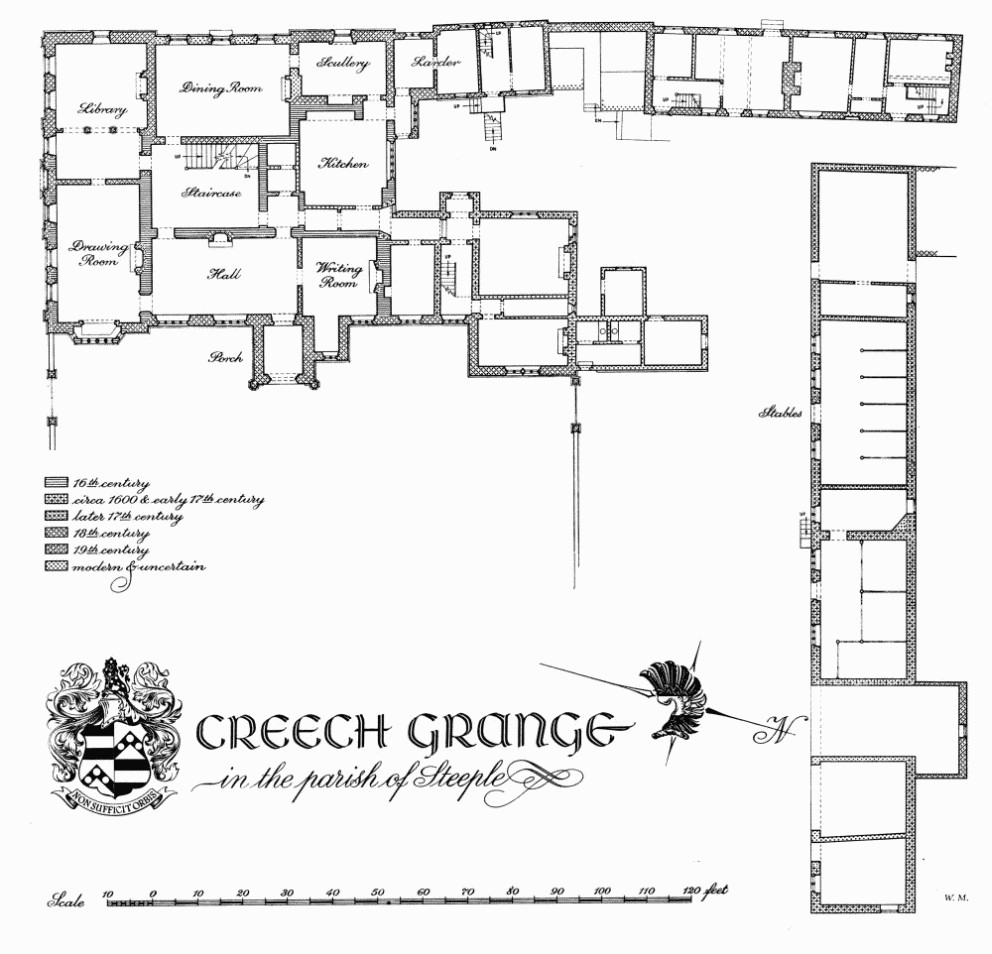
Creech Grange in the Parish of Steeple
Architectural Description—The East Front (Plate 154) is faced with Portland ashlar. Near the centre is a three-storeyed porch with moulded string-courses between the storeys and small octagonal buttresses at the angles finishing above the roof in twisted shafts with foliage finials; on the apex of the gable is a similar shaft and finial. The entrance has a moulded four-centred head and continuous jambs finished with moulded stops; above, under the first-floor window, is a panel carved with a shield-of-arms of Bond. Against the N. side of the porch is a small projection with an embattled parapet. At the S. end the original S. wing projects slightly and has a gable with finial at the apex in the form of a lion; below the gable is a projecting two-storey bay perhaps retaining original 16th-century stonework in the plinth and water-tabling and with 16th-century windows. Between the windows is a panel carved with an achievement-of-arms of Bond. At the N. end of the whole front is a bolder projection than that at the S. end; it also has a gable crowned by a finial in the form of a lion. The lights of the 16th-century windows in the bay at the S. end have arched heads and moulded jambs and mullions; all the other windows, which are of 1846–7, have similar arched lights but the jambs and mullions have simple recessed hollow chamfers except in the N. projection, where the 16th-century mouldings are imitated. All the later windows have moulded labels.
The South Elevation (Plate 154) is faced with Portland ashlar; the centre part projects slightly and has rusticated quoins; the ends are finished with rustication forming inset pilasters above which an entablature is carried across the whole elevation with a pediment over the central projection and a balustraded parapet to each side. The mouldings defining the entablature are very slight except in the cornice to the central pediment which also has modillions. The doorway is formed by RomanDoric pilasters and entablature, above which is a bust of William III in Roman dress; the windows have double-hung sashes set within moulded architraves with keystones. A later window has been added within the pediment.
The West Elevation is rendered in stucco; the ends of the extensions to the original wings are gabled and have windows with double-hung sashes within architraves with plain key-blocks. The centre part is modern but has doorway, windows, cornice and balustraded parapet of the 18th century reused from the W. wall of the stairhall.
The North Side of the kitchen wing is built of Purbeck rubble and has a ground-floor window of five lights which is probably of the 16th century; it has a restored label with 19th-century shield-stops. The North-East Wing has N. and W. walls of rubble with restored mullioned windows with labels and 19th-century W. porch.
Inside, the Hall is lined with 19th-century panelling with shields-of-arms and the ceiling is divided into square panels by moulded ribs; the fireplace has a Gothic stone surround with shields-of-arms and initials N.B. and N.M. for Nathaniel Bond and Nathaniel and Mary. The Drawing Room was enlarged in the 19th century and has a panelled ceiling and moulded cornice of that date; the walls are lined with eared panels above a dado, mostly of the mid 18th century; the fireplace has a marble surround, pulvinated frieze enriched with laurel leaves and enriched cornice; the overmantel has a panel formed by pilasters, cornice and pediment with pendants at each side. The bay window to the E. is framed by 19th-century Corinthian pilasters and contains stained glass shields-of-arms of Bond; seven, of the 17th century, show Bond quarterly impaling (1) Lawrence, (2) Williams, (3) Colt, (4) Williams, (5) Dummer, (6) Lloyd, and the seventh, Bond quarterly of twenty. Twelve impaled shields supplied for the house by Thomas Willement in 1835 are not certainly identifiable.
The Library is divided by a screen of two Ionic columns between pilasters replacing the end wall of the original building; the fireplace has a marble surround with side pilasters curved on plan, a scrolled head and, above the centre, acanthus foliage. The Writing Room is lined with early 18th-century panelling; the fireplace has an eared surround with scrolled side brackets, plain frieze with a central panel enclosing a scallop, and moulded marble cornice. The Staircase of the mid 19th century has a cut string above a continuous, pulvinated lower string, with turned and moulded balusters. Over the staircase is a lantern with clearstorey lights surrounded by elaborate plasterwork, all of the mid 19th century. On the first floor a room over the library is lined with bolection-moulded oak panelling and has a bolection-moulded fireplace surround.
Outbuildings—N. of the house a range of outbuildings running N.-S. is of the 18th century and has been refitted with new windows to form living accommodation. The stable building, a long range running E.-W., is of the 17th century; the higher part to the E. is the earlier and contains a doorway with moulded four-centred head and continuous jambs; in the later W. part is an 18th-century doorway with a round head, key-block, and moulded architrave. Garden walls projecting E. from the ends of the E. front have gateways with wrought-iron gates and scrolled cresting between rusticated pillars.
W. of the house are three artificial lakes, the first of formal rectangular shape and having at its W. end, on a Portland stone pedestal, a marble statue of a man in Roman dress, of c. 1700 (Plate 62).
Grange Arch (912817) was built by Denis Bond before 1746 (Bond papers) as an 'eye-catcher' to form an architectural focus to the view southward from the Grange (Plate 58). It may be compared with the three-arched 'eye-catcher' at Rousham, Oxon., of c. 1740. A central round-headed archway is set under an embattled parapet, and walls extending to each side in two stepped bays contain square-headed openings and round-headed recesses under plain parapets finished with stone pyramids.
c(5) Manor House (130 yds. N. by E.), of two storeys with attics, has walls of coursed rubble with ashlar dressings and roofs covered with stone slates. The house was built perhaps c. 1600 on a simple rectangular plan running N.E.-S.W. and was enlarged in the 17th century by the addition of a S.E. wing and a projection in the angle so formed. On the N.W. front of the original building is a panel with the date 1698 and initials RCR surmounted by a crest of Clavell, probably commemorating the remodelling of the building by Roger and Ruth Clavell (Hutchins I, 570, 597). Soon afterwards, at the beginning of the 18th century, the same members of the Clavell family added a N. wing. Further extensive additions to the N.E. are modern.
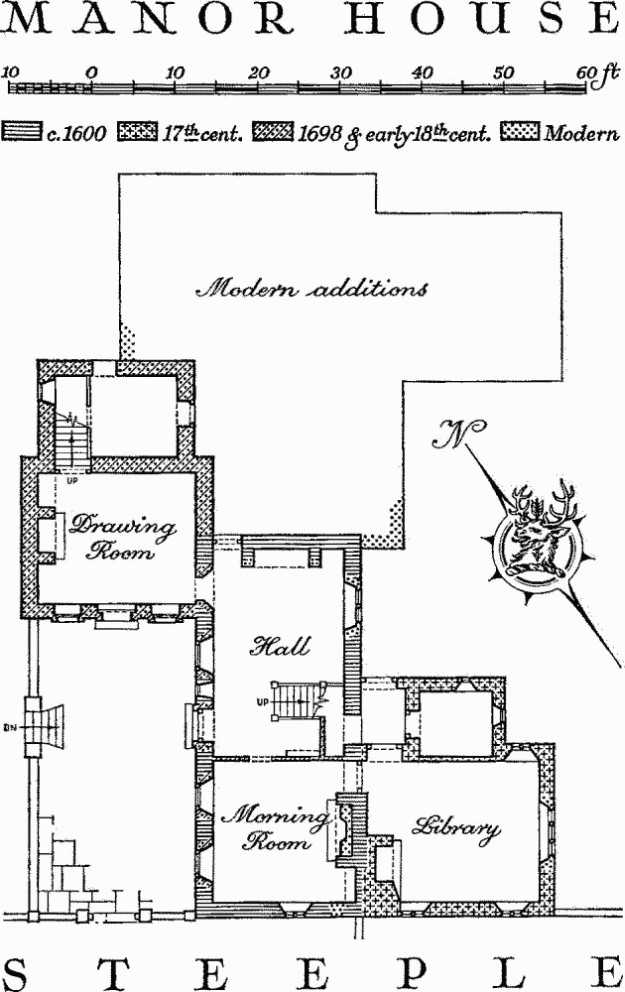
Manor House, Steeple
The original building retains one small original square-headed window to the N.W. and two original windows, one of two lights, in the S.W. end; the entrance doorway has a moulded architrave of 1698 and the other N.W. windows have wooden casements under segmental-arched heads on the ground floor and under timber lintels on the floor above. The S.E. wing has stone-mullioned windows uniform with the original windows of the earlier building, but the one to the ground floor on the S.E. end is modern and those above it have labels. The ground-floor window in the S.E. side of the earlier building is modern. The N. wing has a neat symmetrical elevation to the S.W.; the openings have moulded architraves with keystones and some of the windows retain old iron casements with quadrant stays.
In the S.E. wing some of the doorways have original 17th-century moulded wooden frames, and on the first floor is an original fireplace with moulded stone jambs and lintel. The entrance hall, the drawing room in the N. wing and three of the bedrooms are lined with early 18th-century panelling in two heights with a moulded cornice. The main staircase, probably of 1698, has close strings, turned balusters and square newels capped with ball finials.
c(6) Blackmanston Farm, house (915807), of two storeys with attics, has walls of coursed rubble with ashlar dressings and roofs covered with stone slates. The house was built in the late 16th century on a two-room plan with a staircase in a projecting wing, which has been demolished. Early in the 17th century a through passage and third room were added to the E. end together with a two-storey porch. A long wing to the N. is partly of later date but includes a building, possibly of the 17th century, which was originally separate from the house and to which it is now joined by a single-storey structure.
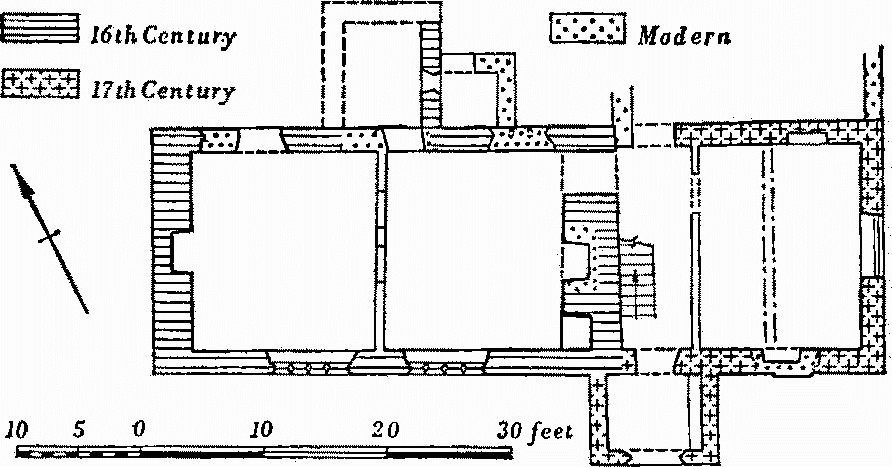
Blackmanston Farm
On the S. front the porch is entered by an archway with moulded four-centred head and continuous jambs. To the W. are four-light ground-floor windows with stone mullions and labels, and two-light first-floor windows; to the E. the windows have been blocked by the later insertion of a chimney, the third room having been originally unheated. Stonemullioned windows also remain in the upper part of the W. end and, blocked, in the N. wall. Other windows, including those in the N. wing, are not original. The interior has been modernised.
c(7) Hyde Cottage (918807), of two storeys with walls of rubble and roofs covered with stone slates, was built c. 1600 on a T-shaped plan with the back wing placed off centre and a stair turret in a re entrant angle. The back wing has been completely rebuilt and the stair turret demolished. The original plan and the 17th-century plan of the Manor House (5) are comparable.
The original windows in the main range have ashlar dressings and mullions; in section some of these are hollow-chamfered, some ovolo-moulded and some ogee-moulded; most of the windows also have moulded labels. Two doorways to the former stair turret have moulded four-centred heads and similar doorways lead into the S. wing. Two original fireplaces have moulded stone jambs and heads.
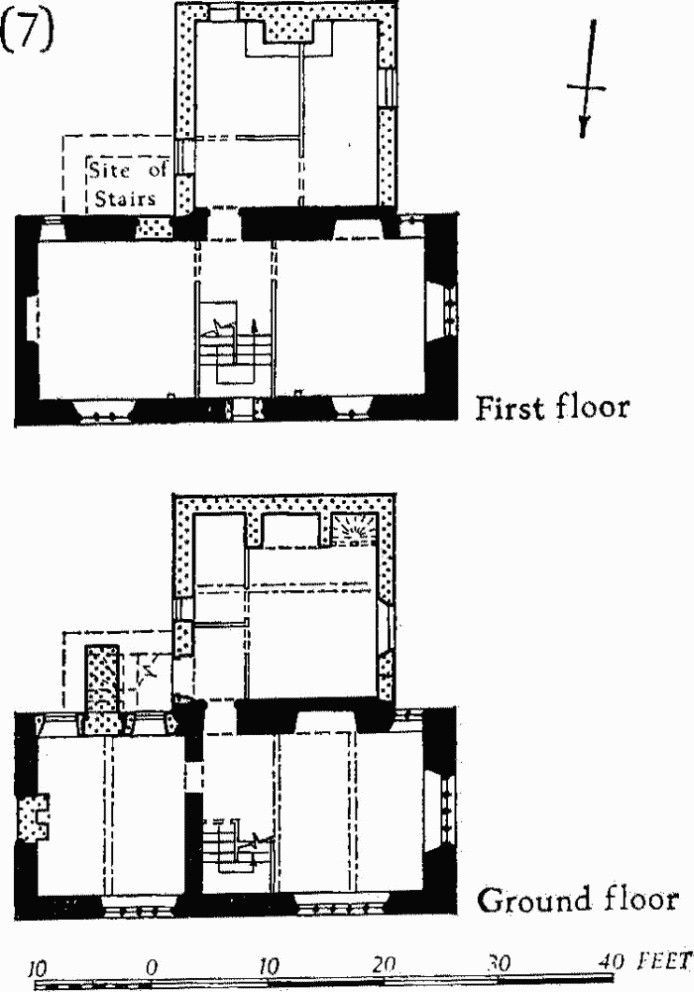
Hyde Cottage
c(8) Hurpston, house (924806), of two storeys with walls of rubble and roof covered with stone slates, was built in the late 18th century on a two-room plan with symmetrical elevation; a wing has been added at the back. (Derelict)
c(9) House (200 yds. N.), of one storey with attics and with rubble walls and thatched roof, is probably of the late 17th century but has been much altered.
c(10) Steeple Leaze Farm, house (909806), of two storeys with rubble walls and slated roof, is probably of the early 18th century but has been much altered and at one time was adapted to form two tenements.
b(11) Shepherd's Cottage (903799), of two storeys with rubble walls and thatched roof, is of the late 18th century.
(Derelict)
c(12) Lutton Farm, house (901809), of two storeys with walls of rubble and roof covered with stone slates, is of the late 17th or early 18th century. The windows are of two lights with ashlar dressings and mullions and over the lower windows is a weathered string-course. Barn, W. of house, is of the 17th century; it comprises seven bays with the roof carried on jointed-cruck trusses with roughly arch-braced collar beams.
(All derelict)
c(13) Broadmoor Farm, house (900830), is mainly of mid 19th-century brick but includes some earlier cob and rubble walling. (Ruinous)
a(14) Rookery Cottages, a pair (888829), built in the mid 19th century with walls mainly of cob but partly with original brick facing, has a central chimney built of cob, about 7 ft. square at the base and tapered to support a small brick shaft above the roof. (Ruinous)
Earthworks, etc.
Mediaeval and Later Earthworks (Fig., Pt. 1, p. xxxviii).
c(15) Settlement Remains at Lutton (901809), cover some 5 acres near the deserted farm (12). The site was 'anciently a manor and hamlet and a member of Povington' (Hutchins (1st ed.) I, 207). At least three house platforms stand out dry from water-logged surroundings in two small areas. Traces of broad and narrow rig remain to the S. (R.A.F. V.A.P. CPE/UK 1821:5420.)
c(16) Settlement Remains (910809), formerly part of Steeple, cover about 1½ acres around the church; the village had been partly depopulated for a farm by the 17th century (Hutchins (1st ed.) I, 202).
The remains consist of a roughly rectilinear pattern of hollow-ways on either side of a small W.-E. valley, together with banks, closes and platforms. At least three of the platforms lie due E. of the church, one originally about 75 ft. square; a roughly circular mound 25 ft. in diam. lies to the S.E. (Steeple 26). N.W. of the church (90978104) are three other platforms 25 ft. square.
In the S.W. corner of the area (90928091) is a circular embanked hollow about 12 ft. in diam., perhaps a windmill site, with an entrance into a hollow-way on the N.W. (R.A.F. V.A.P. CPE/UK 1821: 5418.)
c(17) Settlement Remains at Blackmanston (916806) lie about ⅓ mile S.E. of Steeple Church on either side of the Corfe River, here a very narrow stream flowing in a deep-cut channel. The settlement is identifiable in Domesday Book (Fägersten, 134).
The site is sheltered by the limestone ridge to the S. and is on Wealden Beds, but the lower areas N. of the river are now very wet. Immediately S.E. of Blackmanston Farm and above the 200 ft. contour line is an almost flat area of about 1 acre; it is defined on the E. and S. by a scarp up to 3 ft. high skirted by a hollow track. At the N.E. two platforms, 30 ft. by 12 ft. and 45 ft. by 15 ft., with traces of limestone in their scarps, are inset into the scarp bounding the area. Another platform on the W. has been cut by the road dividing the site from the farm buildings. There are several other indistinct levelled areas and sites of former closes are marked on the slope to the S. by disturbed banks and ditches. On the S. side of the river, 100 yds. to the S.E. of these remains, is an isolated platform 18 ft. by 15 ft.: when this was recently disturbed, ashlar was found as well as rough limestone. (R.A.F. V.A.P. CPE/UK 1821: 5417–8.)
c(18) Settlement Remains at Hurpston (925806), cover 1 acre around the Farm, itself now deserted; in Domesday Book the place is called 'Herpere' (Hutchins (1st ed.) I, 206; Fägersten, 136; R.A.F. V.A.P. CPE/UK 1821: 5417).
Other Earthworks and Allied Monuments
(19–25) Round Barrows, p. 451.
(26) Mound, see (16) above.
(27) The Harpstone, p. 515.
(28–31) Roman Remains, p. 608.
Ancient Field Groups (18, 20), p. 629.
